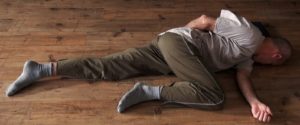
A foreword by Yosefa before the lesson:
“The lesson we will witness will be compressed to a single movement each time, and not spread out in 45 minutes.
We will see how one movement can be taken to other body parts, while being in-tuned to them and learning about how each of them works: which parts move better, which are more problematic.
In this case the attention will go to the hip joints – how straight they are while passive, how arched is the lumbar region – perhaps not much, how spread are the shoulder blades with the arms & hands turned out, and how long is the neck with the help of a pillow.
I will ask you to listen to your entire body, to the things you want to listen to, to the things you know are changing within you”.A reference to a comprehension of the body stemming from one movement:
While lying on your back, right leg straight down and left leg close to the chest (repeat on the other side):
the movement develops to a roll to the left and to a sitting knee to foot position;
and a roll to the right to chest lying on the left flexed outward leg.
This could be expanded to a full lesson of course, by repeating each movement several times.
The movements encourage:
constantly working with the abdominal muscles to prevent an arched lumbar region.
This promotes the strengthening of the abdominal muscles by the awareness of their proper use.
The soft tissues of the frontal hip joint of the straight leg are lengthened.
Each student is made aware of his movement range by straightening the leg;
of the connection between flattening the lumbar region and the need to give length in front at the hip joint of the straightened out leg;
of the passive bending of the straight knee as a result of the lack of length in the front hip joint.
The movements use the rotation of the back; the flexibility of the shoulder joints in a few directions.
A sense of timing is acquired of the joining small movements which together form a large movement.
